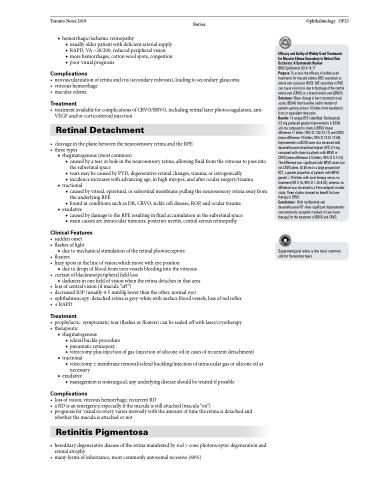Page 913 - TNFlipTest
P. 913
Toronto Notes 2019
Retina
Ophthalmology OP23
■ hemorrhagic/ischemic retinopathy
◆ usually older patient with deficient arterial supply ◆ RAPD, VA ~20/200, reduced peripheral vision
◆ more hemorrhages, cotton wool spots, congestion ◆ poor visual prognosis
Complications
• neovascularizationofretinaandiris(secondaryrubeosis),leadingtosecondaryglaucoma • vitreoushemorrhage
• macularedema
Treatment
• treatmentavailableforcomplicationsofCRVO/BRVO,includingretinallaserphotocoagulation,anti- VEGF and/or corticosteroid injection
Retinal Detachment
• cleavageintheplanebetweentheneurosensoryretinaandtheRPE
• threetypes
■ rhegmatogenous (most common)
◆ caused by a tear or hole in the neurosensory retina, allowing fluid from the vitreous to pass into
the subretinal space
◆ tears may be caused by PVD, degenerative retinal changes, trauma, or iatrogenically
◆ incidence increases with advancing age, in high myopes, and after ocular surgery/trauma
■ tractional
◆ caused by vitreal, epiretinal, or subretinal membrane pulling the neurosensory retina away from
the underlying RPE
◆ found in conditions such as DR, CRVO, sickle cell disease, ROP, and ocular trauma
■ exudative
◆ caused by damage to the RPE resulting in fluid accumulation in the subretinal space ◆ main causes are intraocular tumours, posterior uveitis, central serous retinopathy
Clinical Features
• suddenonset • flashesoflight
■ due to mechanical stimulation of the retinal photoreceptors • floaters
• hazyspotsinthelineofvisionwhichmovewitheyeposition
■ due to drops of blood from torn vessels bleeding into the vitreous
• curtainofblackness/peripheralfieldloss
■ darkness in one field of vision when the retina detaches in that area
• lossofcentralvision(ifmacula“off”)
• decreasedIOP(usually4-5mmHglowerthantheother,normaleye)
• ophthalmoscopy:detachedretinaisgrey-whitewithsurfacebloodvessels,lossofredreflex • ±RAPD
Treatment
• prophylactic:symptomatictear(flashesorfloaters)canbesealedoffwithlaser/cryotherapy • therapeutic
■ rhegmatogenous
◆ scleral buckle procedure
◆ pneumatic retinopexy
◆ vitrectomy plus injection of gas (injection of silicone oil in cases of recurrent detachment)
■ tractional
◆ vitrectomy ± membrane removal/scleral buckling/injection of intraocular gas or silicone oil as
necessary ■ exudative
◆ management is nonsurgical; any underlying disease should be treated if possible
Complications
• lossofvision,vitreoushemorrhage,recurrentRD
• aRDisanemergency,especiallyifthemaculaisstillattached(macula“on”)
• prognosisforvisualrecoveryvariesinverselywiththeamountoftimetheretinaisdetachedand
whether the macula is attached or not
Retinitis Pigmentosa
• hereditarydegenerativediseaseoftheretinamanifestedbyrod>conephotoreceptordegenerationand retinal atrophy
• manyformsofinheritance,mostcommonlyautosomalrecessive(60%)
Efficacy and Safety of Widely Used Treatments for Macular Edema Secondary to Retinal Vein Occlusion: A Systematic Review
BMC Ophthalmol 2014;14:17
Purpose: To assess the efficacy of widely used treatments for macular edema (ME) secondary to retinal vein occlusion (RVO). ME secondary to RVO can cause vision loss due to blockage of the central retinal vein (CRVO) or a branch retinal vein (BRVO). Outcomes: Mean change in best corrected visual acuity (BCVA) from baseline and/or number of patients gaining at least 10 letters from baseline to 6 mo or equivalent time point.
Results: 14 unique RCTs identified. Ranibizumab 0.5 mg produced greater improvements in BCVA
at 6 mo compared to sham in BRVO (mean difference 11 letters; 95% CI 7.83-14.17) and CRVO (mean difference 14 letters; 95% CI 10.51-17.69). Improvements in BCVA were also observed with dexamethasone intravitreal implant (IVT) 0.7 mg compared with sham in patients with BRVO or CRVO (mean difference 2.5 letters; 95% CI 0.7-4.3). The difference was significant with BRVO alone, but not CRVO alone. At 36 mo in a large prospective RCT, a greater proportion of patients with BRVO gained >15 letters with laser therapy versus no treatment (OR 3.16; 95% CI 1.25-8.00), whereas no difference was observed in a 9 mo endpoint smaller study. Three studies showed no benefit for laser therapy in CRVO.
Conclusions: Bothranibizumaband dexamethasone IVT show significant improvements over previously accepted standard of care (laser therapy) for the treatment of BRVO and CRVO.
Superotemporal retina is the most common site for horseshoe tears


